REFLECTIVE PRACTICE
Finlay (2008) stated that to be a powerful tool to examine and transform practice, critical reflection needed to be refined and grown.
After completing the reflective practice
survey and considering the 5 levels of reflection as defined by Zeichner &
Liston (1996), my current reflective practice is at the Rapid Reflection and Repair level. I need to shift to
Research and Retheorizing and
Reformulating to refine and grow my practice.
Firstly, I selected a suitable model of reflection to augment the quality of my reflective
practice. Finlay (2008) discusses a variety
of reflective practice models; Gibbs’ Reflective Cycle (1988), The three-stage
model of Boud, Keogh and Walker (1985) and John’s Model of Structured
Reflection (2006). I have
selected Jay and Johnson’s (2002) model as the three intertwined dimensions of;
descriptive, comparative and critical reflection are more consistent with the
Spiral Model of Inquiry where it cycles through:
scanning
– focussing – developing a hunch – new learning – taking action
(Halbert
& Kaser, Spirals of Inquiry, 2013).
Finlay (2008) quantified that
models like that of Jay and Johnson (2002) are useful as they recognise
different levels of reflection. I can see the deeper spiraling questions that
are an integral part of the Jay and Johnson (2002) model easy to apply to my reflective
practice learning journey.
COMMUNITIES
OF PRACTICE
Wenger (2002)
defines a community of practice as
a group of people who share a passion for something they know how to do and who
interact regularly to learn how to do it better. The purpose is to create,
expand and share knowledge and to develop individual capabilities.
There are three essential
elements that define a Community of Practice over a community. The
- Domain of Knowledge – which defines a set of issues.
- The Community – the people who care about this domain.
- The Practice – The shared practice community members are developing to be effective in the domain. (Wenger et al. 2002)
The shared domain of interest that I identify with the Community
of Practice at my school, is that of
collectively inspiring and supporting all learners to reach their highest
potential.
As a CoP, my colleagues
frequently come together as professionals. Learning is for us, “an evolving, continuously renewed set of relations” (Lave and
Wenger 1991,
p. 50). We have regular staff and team meetings, with these always
having an element of professional development. In these meetings, we often
exchange ideas and share knowledge. Professional dialogue and relationships are
an integral part of ‘who we are’. My personal professional up skilling, through
Mind Lab, Write That Essay courses, attending the Oral Language Book workshop and working
with a literacy ‘guru’ in the area, has given me many opportunities to share my
new learning with our CoP. Our staff also actively contribute to the CoP by
voluntarily:
- Holding workshops (from using the NZ Math website to programming robots and sharing art ideas)
- Sharing links and activities through email.
- Organising key professionals to share their knowledge with us.
- Discussing ideas that many help with some of the challenges our colleagues have with their ākonga.
- ‘Chewing the fat’ by the photocopier, as sometimes it is helpful to verbalise our tacit knowledge.
I feel a strong sense of connectedness with our
CoP. I belong and have an affinity with my colleagues. My role would be ‘an
active member’ where I often share pedagogical aims
and practices to enhance children’s learning and
wellbeing. I will keep a focus on moving the Reflection Indicators to Research and Retheorizing and
Reformulating (Zeichner & Liston 1996) and apply the Jay and Johnson (2002) model against the
concepts of a CoP as outlined by Wenger (2002). With this approach in place, I will have a
solid base on which to critically define, and grow my practice for the
betterment of my students, their whanau and myself.
Interestingly, in 2000, Wenger, E.
C., & Snyder, W. M. (2000) stated that CoP are the new frontier. Now we are
considering COOLs (Communities of Online Learning).
Derek’s Blog is an interesting read.
Derek’s Blog is an interesting read.
REFERENCES
‘Derek’s Blog’, retrieved from:
Halbert,
J., & Kaser, L. (2013). Spirals of inquiry. Vancouver, BC: BC
Principals and Vice Principals Association.
Jay, J.
K., & Johnson, K. L. (2002). Capturing complexity: A typology of reflective
practice for teacher education. Teaching and teacher education, 18(1),
73-85.
Knox, B. (2009, December 4).
Cultivating Communities of Practice: Making Them Grow.[video file]. Retrieved
from https://www.youtube.com/watch?v=lhMPRZnRFkk
Lave, J.,
& Wenger, E. (1991). Situated learning: Legitimate peripheral participation.
Cambridge: Cambridge University Press.
Wenger, E. C., & Snyder, W. M.
(2000). Communities of practice: The organizational frontier. Harvard business
review, 78(1), 139-146.
Wenger, E., McDermott, R. A., & Snyder, W.
(2002). Cultivating communities of practice: A guide to managing
knowledge. Harvard Business Press



Comments
Post a Comment